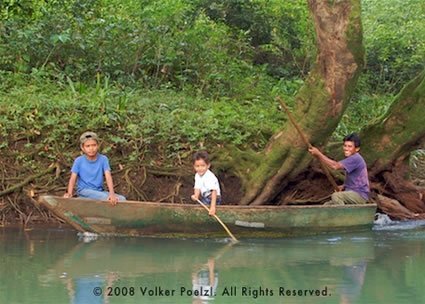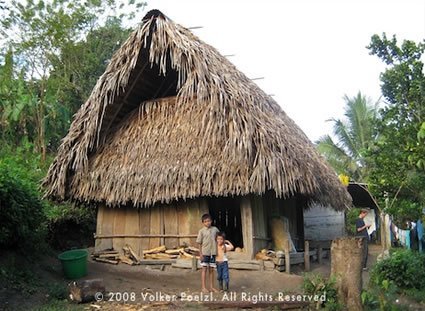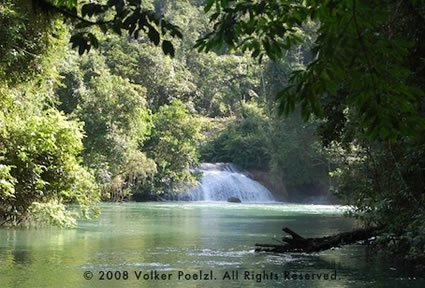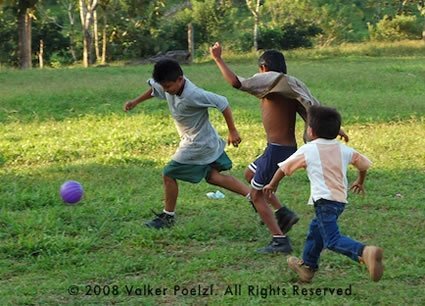玛雅村庄生活的一天危地马拉的土著社区旅游Article and photos by Volker Poelzl
 |
| 独木舟是许多玛雅人的重要交通工具。 |
Guatemala is among Central America’s most popular travel destinations. About a million tourists flock to the small country each year to visit Mayan ruins, colonial towns, and of course the colorful Mayan markets, which are among the highlights of any visit to Guatemala. Although many visitors admire and purchase Mayan handicrafts and textiles, listen to marimba bands, and photograph colorful market scenes, very few travelers venture a step further to actually visit Mayan villages and learn about the culture and way of life of the Mayan people. To offer an alternative to the main tourist trail that leads from Antigua, to Lake Atitlán and the famous Chichicastenango market, several NGOs are promoting stays in Mayan villages all across Guatemala. These visits give travelers the unique opportunity to go beneath the surface and experience the culture and way of life of the Mayan people. In some areas the local NGOs also collaborate with aid organizations, giving visitors the opportunity to do volunteer work while they stay at a village or with a Mayan family. What to Expect Most of the NGOs offering cultural immersion programs operate in little visited areas in Guatemala and work with small communities. Experiencing the way of life of the local people is one of the main attractions of these programs, in addition to exploring Guatemala’s fascinating ecosystems, such as cloud forests, remote mountain valleys, dense rainforests, and mangrove-lined lagoons. Staying with a local family or at a village guesthouse is a great experience, but visitors should be aware of local conditions before going into remote areas. 通往偏远村庄的道路状况通常很差,您至少会在土路上旅行。预计将与其他村民,他们的孩子,鸡和农产品一起花几个小时在一辆小型和拥挤的小型货车上。并非所有村庄都有电力,与外界的联系通常很困难。村庄可能只有一部电话,在较小的社区中,只有一辆每日巴士或面包车回到城镇。 Visitors stay at a village guesthouse or in the hut of a local family, enjoy their meals with their hosts, and are offered a variety of activities, such as cultural events and excursions to the nearby natural attractions. You may also be able to accompany your hosts on their daily work routines, such as visiting agricultural plots or going fishing. Village guests are encouraged to sample traditional foods, but since the villages are poor, you will most likely be served simple meals. In addition to huge piles of corn tortillas, the main staple food of the Mayans, my host family in a small jungle village in the Verapaces region served eggs, chicken, pasta, and beans, which was a simple but varied enough menu plan to keep me well fed for a few days. In case bottled water is not available, it is a good idea to bring a water filter or purification tablets. Also, bring all the extra food and drink you would like to consume during your stay. Some basic items and soft drinks may be available at village stores, but you should not count on it. If you are bringing snacks or sweets, keep the village children in mind and buy a little extra to share.
 |
| 我的寄宿家庭在北部危地马拉雨林中的小屋。 |
乡村旅馆更舒适,设备更好,并且与与寄宿家庭一起住在小屋中的私密性更多。如果隐私和生物的舒适感对您来说是重要的问题,那么您可能需要考虑一个村庄住宿,在这里您可以在社区旅馆中拥有自己的私人房间。床上用品可能并不总是符合西方标准,如果可以的话,最好带一个露营床垫和/或睡袋。与当地家庭住在小屋时,不要期望私人浴室或淋浴。大多数村民在最近的小溪里洗澡,这总是在午后社交活动的好地方,当时人们在田野里工作了一天后洗澡。通常有几个家庭共享的外屋。在没有电力的村庄中,蜡烛在天黑后提供唯一的照明,家人很早就上床睡觉。如果您打算熬夜,请带上手电筒和灯笼。
 |
| 许多接待客人的村庄都有附近的自然景点。 |
请记住,您是村庄和寄宿家庭的客人,而不仅仅是游客。在玛雅村庄的低成本住宿不应被视为酒店住宿的廉价替代品。在偏远的土著社区中度过几天与住在旅馆或酒店有很大不同。住在玛雅村庄是一个很好的机会,可以陪伴村民或您的寄宿家庭日常活动,并了解他们的生计,食物和家庭生活。您将成为家庭生活的一部分,并且您将与寄宿家庭一起留在公共区域,而没有隐私。我和我的旅行伴侣在夜间与家人分享了一个大型茅草小屋。希望您的房东的孩子无论您走到哪里。您的访问对他们来说是一个可喜的变化,如果您说西班牙语并愿意和他们一起踢足球,他们将特别注意。
 |
| Soccer is the favorite game of many Mayan children. |
您访问的好处 许多乡村住宿计划都位于新定居点的地区,主要是由不同种族背景的玛雅人民在内战期间流离失所的。这些家庭逃离了他们的家庭社区,搬到了偏远的山区和丛林地区,开始了新的生活。这些村庄中的许多人不到20年,几乎没有获得基础设施和发展的政府援助。森林,河流和湖泊是收入和生计的主要来源,森林砍伐,过度狩猎和过度捕捞对脆弱的当地生态系统产生不可逆转的影响。在某些地区,国家公园管理局(National Parks Administration)支付了当地的村庄社区,以维护和保护充当邻国公园的缓冲区的小型森林保护区。该管理计划是许多社区收入来源之一,除了少量的碰撞作物,例如豆蔻,玉米和豆类。尽管少数外国游客对当地经济没有重大影响,但他们仍然通过访问为保护自然环境做出积极贡献。自然奇观是许多社区旅游项目的主要景点之一,您的访问鼓励持续保护和可持续使用当地生态系统。因此,留在村庄不仅是一种伟大的文化经验,而且还为当地人提供了进一步的动力来保护他们的生态宝藏,以吸引游客并为社区带来收入。 去哪儿 为了体验玛雅文化和生活方式,旅行者需要准备离开Gringo小径,冒险进入危地马拉的偏远和访问少量地区。尽管访问通常很耗时且困难,但游客将获得构成危地马拉玛雅人口的各种族裔的丰富经验。下面,我列出了危地马拉的几个地区,非政府组织在那里为当地村庄提供社区旅游项目。 The Cuchumatán Mountains I have found the Cuchumatán Mountains to be one of the most fascinating regions in Guatemala to experience local Mayan life. The imposing mountain range stretches across northern central Guatemala and is home to many small towns and communities, where visitors can get a first-hand experience of daily life of the local population and their culture. This area was strongly affected by the Guatemalan civil war, when many villagers were displaced by the fighting between the Guatemalan army and guerilla groups. Life is slowly returning to normal, but the remote mountain communities are economically underdeveloped and lack many services. The town of Nebaj is a great base from where to organize a stay in a local village. VATAPACE区域 Verapaces地区位于危地马拉北部,位于危地马拉高地和尤卡坦半岛低洼平原之间的过渡区。It is equally divided between mountains covered in cloud forest and low-lying rainforest to the north, offering visitors a fascinating and diverse ecosystem that is both home to rare fauna and flora, such as the rare and endangered Quetzal, Guatemala’s national bird, as well as numerous indigenous Mayan communities. Cobán is the region’s capital, a pleasant town surrounded by coffee plantations. It is here where visitors can make arrangements for a cultural immersion experience in local Mayan communities. 彼得恩的雨林 Petén, Guatemala’s northernmost department, is a low plain at the southern tip of the Yucatán Peninsula. It is covered with dense rain forest and is a sparsely populated region. Besides tourism to the famous Mayan ruins of Tikal, there is little tourism development and infrastructure. Several NGOs and community projects offer stays in Mayan villages to experience the local culture, visit remote Mayan ruins, and explore the region’s rich fauna and flora. The Rio Dulce/Golfete Region 里约热内卢河流排干危地马拉东部,到达利文斯顿镇附近的加勒比海。与危地马拉的许多其他地区一样,属于国家公园的一部分的里约杜尔斯银行(Rio Dulce)的银行已经由玛雅人(Mayans)解决,他们逃离了家庭社区中的内战暴力。这些定居点大多数都是非法的,因此政府服务大部分是缺乏的。为了帮助这些新建立的社区,几个非政府组织和社区项目已经开始开发基本的基础设施,以吸引社会和环保的旅行者。几个村庄在社区旅馆中提供寄宿家庭和住宿,并为探索该地区丰富的生态系统提供指导之旅。 Volker Poelzlis a Living Abroad Contributing Editor for TransitionsAbroad.com.During his recent trip to Guatemala he visited a number of indigenous communities all over the country.
|
